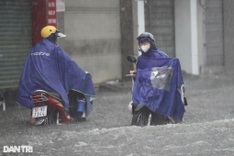>> Statue defiled at legendary festival
Pagodas and temples are sacred places, but many visitors behave as if they were not.
Visiting pagodas and temples at the beginning of the Lunar New Year has become an age-old tradition of Vietnamese people, who have been flocking to these places in large numbers. However, the behaviour of some of them has brought a negative impact on these places.

Money surrounding the statue at Temple of Literature
There are donation boxes scattered around Soc Temple in Soc Son District, Hanoi. Still visitors piously leave their donations of small bills all around; on an alter, the base of a tree or statue, anyplace an incense burner might be located.
This has created an opportunity for those who would violate the religious atmosphere of these holy places. Thieves wait around for people to make donations, taking the money for themselves.
Pagodas and temples are often surrounded by parks and gardens. Now it is not an uncommon sight to see couples kissing and caressing in these places. This is considered extremely disrespectful, no matter how pleasant it may be for the couples.
Statues of sacred deities, such as the Elephant Deity, are swarmed by people, rushing to take photos. This particular offering is part of the rites of Saint Giong. The disorderly behaviour to be seen these days is not in line with traditional respect these ancient sites demand.
The rush towards these statues resembles a pushing queue more than it does a sacred place. The people push to touch the deity, receive their blessings and press their money into the crevices of the elephant statue in hopes of good luck.
Mr. Nguyen Van Nam is frustrated. “I brought my six-year old daughter to teach her about the Elephant Deity, who helps Saint Giong to protect our country. Suddenly; several people came around us, grabbing the ears and tail. I will have to take her to other places because I don’t want her to see this, and it to affect her behaviour.”
The same type of scene can be seen at at An Duong Vuong Temple in Dong Anh District, Hanoi. Small change is strewn all over the temple. Worshipers race with each other to pour money into the headless statue of the Princess of My Chau.
“Streams of rubbish” at Huong Pagoda
Huong Pagoda in My Duc District, in Hanoi, is a famous for charming landscapes. But it is also famous for the litter that surrounds it. These days, Yen Stream, through which all travelers must pass before going to the pagoda, has been turned into a stream or rubbish.
Even though it has just opened, the festival at Huong Pagoda receives tens of thousands of tourists.
Previously, the waters of Yen Stream were blue and clear. Now, however, it is full off plastic bags and bottles. Garbage leaves a bad smell and a worse environmental impact.
Rubbish is freely thrown into the stream although dozens of workers are assigned to deal with the litter problem and hundreds of trashbins have been placed along the stream. Trinh Temple near the stream is also covered with rubbish.
Vice Chairman of Soc Son District People’s Committee said that the bad behaviour at temples and pagodas is simply caused by ignorance. However, due to the large influx of people, and not enough management, the situation is difficult to control.
According to Tran Thi Tuyet Mai, from the Cultural Heritage Department, under the Ministry of Culture, Sports and Tourism, the number of visitors to festivals, temples and pagodas have greatly increased this year against, which has had adverse effects on the environment.

Those who give offerings may not know where the money will end up

Money is stuffed into stone statutes

Headless My Chau is offered small change
The following is photos taken at Huong Pagoda:

Rubbish along Yen Stream

Plastic bags and bottles are bad for aesthetics and the environment


Most of litter is nylon bags and plastic bottles

Trinh Temple filled with garbage

Smoke surrounds the pagoda




















